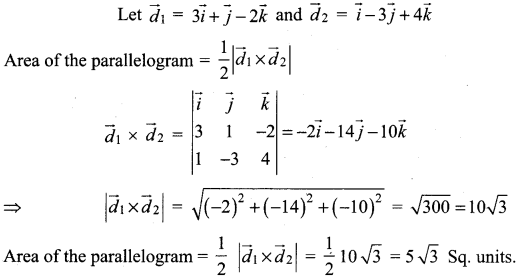You can Download Samacheer Kalvi 12th Maths Book Solutions Guide Pdf, Tamilnadu State Board help you to revise the complete Syllabus and score more marks in your examinations.
Tamilnadu Samacheer Kalvi 12th Maths Solutions Chapter 6 Applications of Vector Algebra Ex 6.1
Question 1.
Prove by vector method that if a line is drawn from the centre of a circle of a circle to the midpoint of a chord, then the line is perpendicular to the chord.
Solution:
Let ‘C’ be the mid point of the chord AB
Take ‘O’ on the centre of the circle.
Since, OA = OB (Radii)
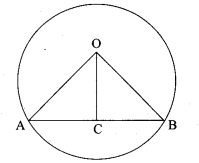
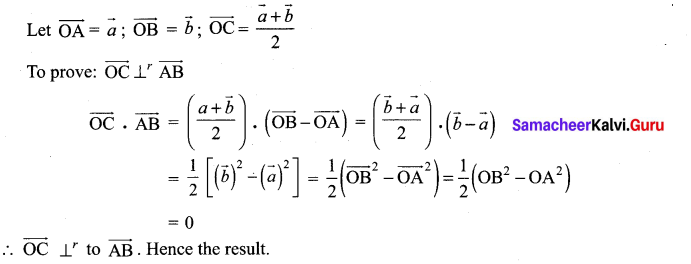
Question 2.
Prove by vector method that the median to the base of an isosceles triangle is perpendicular to the base.
Solution:
Let OAB be an isosceles triangle with OA = OB
Let OC be the median to the base AB
C is the midpoint of AB
Take O as origin.
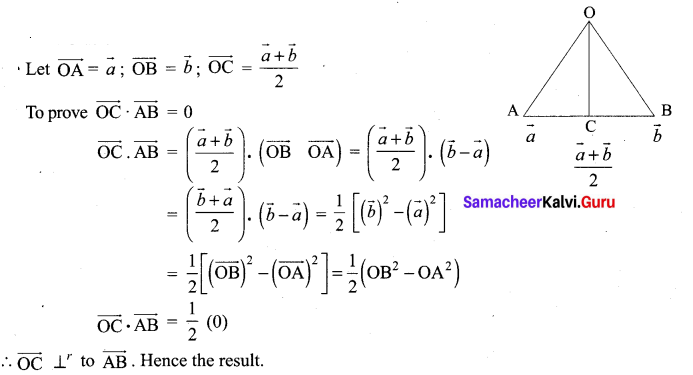
![]()
Question 3.
Prove by vector method that an angle in a semi-circle is a right angle.
Solution:
Let AB be the diameter of the circle with centre ‘O’
Let P be any point on the semi-circle.
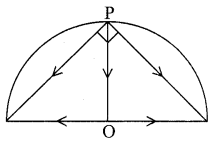
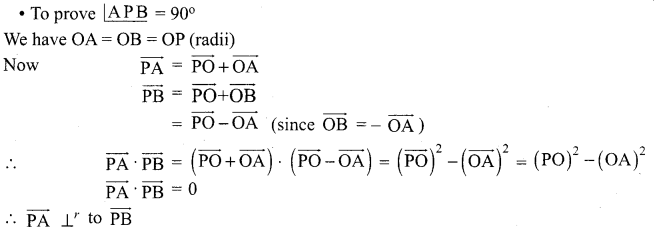
This gives ∠APB = 90°. Hence the result.
Question 4.
Prove by vector method that the diagonals of a rhombus bisect each other at right angles.
Solution:
Let ABCD be a rhombus
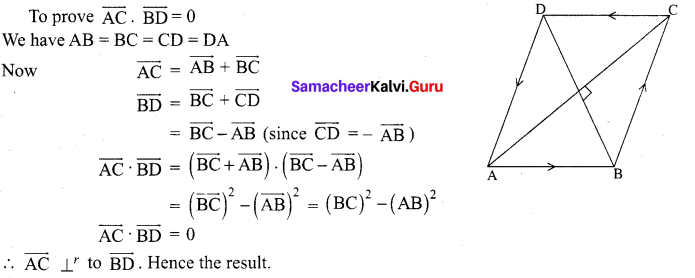
Question 5.
Using vector method, prove that if the diagonals of a parallelogram are equal, then it is a rectangle.
Solution:
Let ABCD be a parallelogram
To prove ABCD be a rectangle provided the diagonals are equal.
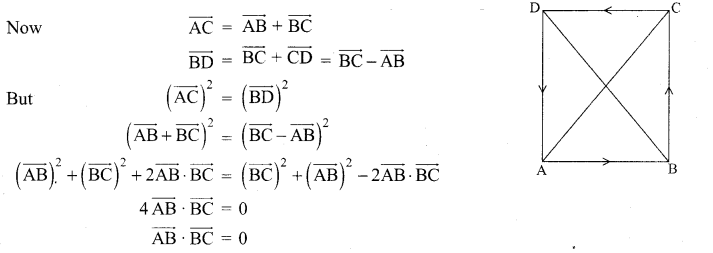
\(\overrightarrow{\mathrm{AB}}\) ⊥r to \(\overrightarrow{\mathrm{BC}}\)
⇒ ABCD is a rectangle.
Question 6.
Prove by vector method that the area of the quadrilateral ABCD having diagonals AC and BD is \(\frac{1}{2}|\overrightarrow{\mathrm{AC}} \times \overrightarrow{\mathrm{BD}}|\)
Solution:
Vector area of quadrilateral ABCD = {Vector area of ∆ABC} + {Vector area of ∆ ACD}
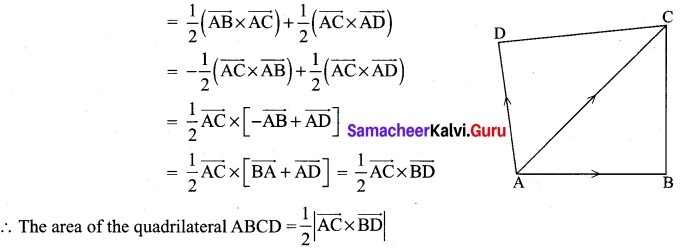
Question 7.
Prove by vector method that the parallelogram on the same base and between the same parallels are equal in area.
Solution:
Let ABCD and ABC’D’ be two parallelogram between the parallels with same base
To prove: Area of ABCD = Area of ABC’D’
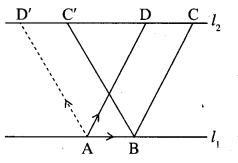

![]()
Question 8.
If G is the centroid of a AABC, prove that.
(area of ∆GAB) = (area of ∆GBC) = (area of ∆GAC) = \(\frac{1}{3}\) [area of ∆ABC]
Solution:
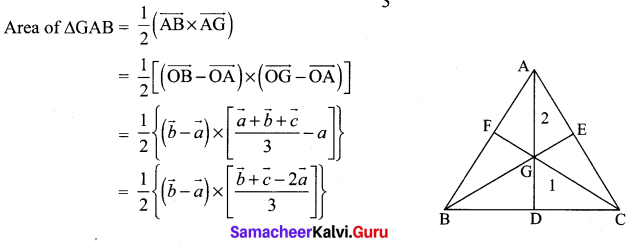

Similarly we can prove
Area of ∆GBC = Area of ∆GAC = \(\frac{1}{3}\) [Area of ∆ABC]
Question 9.
Using vector method, prove that cos(α – β) = cos α cos β + sin α sin β.
Solution:
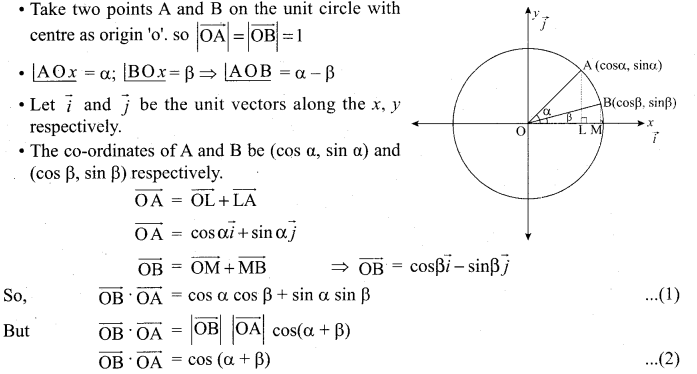
From (1) and (2), we get
cos(α + β) = cos α cos β + sin α sin β
Question 10.
Prove by vector method that sin(α + β) = sin α cos β + cos α sin β.
Solution:
Take two points A and B on the unit circle with centre as origin ‘O’, so \(|\overrightarrow{\mathrm{OA}}|=|\overrightarrow{\mathrm{OB}}|\) = 1
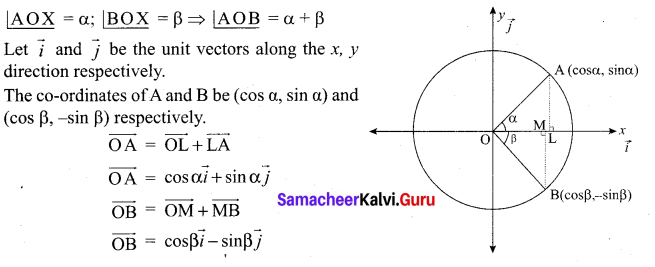

From (1) & (2), we get
sin (α + β) = sin α cos β + cos α sin β
Question 11.
A particle acted on by constant forces \(8 \vec{i}+2 \vec{j}-6 \vec{k}\) and \(\overrightarrow{6 i}+2 \vec{j}-2 \vec{k}\) is displaced from the point (1, 2, 3) to the point (5, 4, 1). Find the total work done by the forces.
Solution:
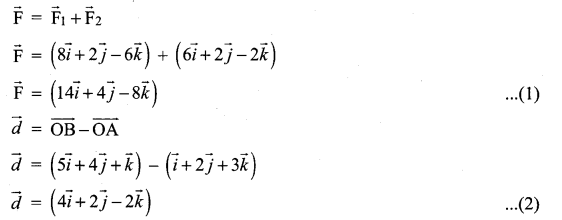
From (1) & (2), we get
Work done by the force = \(\overrightarrow{\mathrm{F}} \cdot \vec{d}\) = 56 + 8 + 16 = 80 units.
Question 12.
Forces of magnitude \(5 \sqrt{2}\) and \(10 \sqrt{2}\) units acting in the directions \((3 \vec{i}+4 \vec{j}+5 \vec{k})\) and \((10 \vec{i}+6 \vec{j}-8 \vec{k})\), respectively, act on a particle which is displaced from the point with position vector \((4 \vec{i}-3 \vec{j}-2 \vec{k})\) to the point with position vector \((\overrightarrow{6 i}+\vec{j}-3 \vec{k})\). Find the work done by the forces.
Solution:
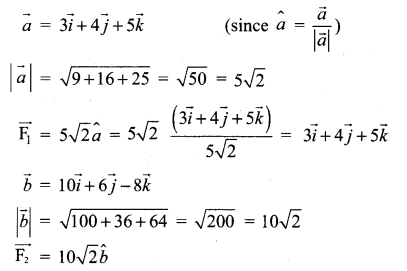
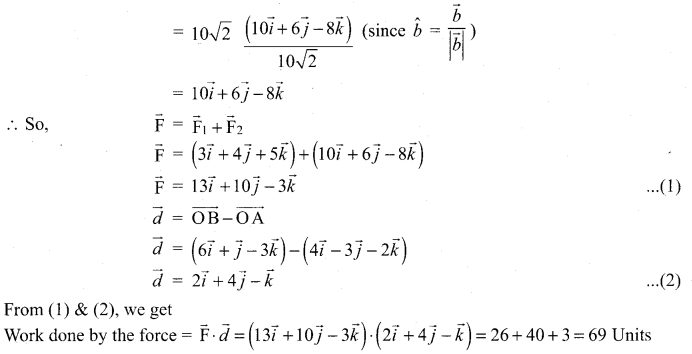
![]()
Question 13.
Find the magnitude and direction cosines of the torque of a force represented by \(3 \vec{i}+4 \vec{j}-5 \vec{k}\) about the point with position vector \(2 \vec{i}-3 \vec{j}+4 \vec{k}\) acting through a point whose position vector is \(\overrightarrow{4 i}+2 \vec{j}-3 \vec{k}\).
Solution:
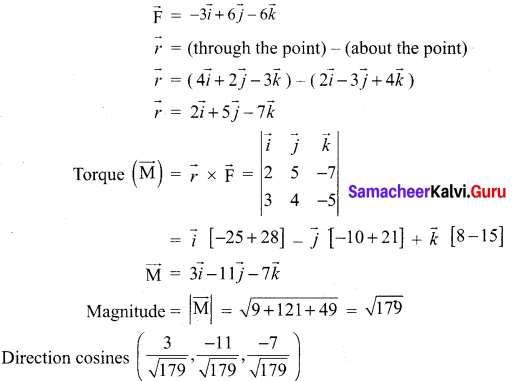
Question 14.
Find the torque of the resultant of the three forces represented by \(-3 \vec{i}+6 \vec{j}-3 \vec{k}\), \(\overrightarrow{4 i}-10 \vec{j}+12 \vec{k}\) and \(\overrightarrow{4 i}+7 \vec{j}\) acting at the point with position vector \(8 \vec{i}-\overrightarrow{6} \vec{j}-4 \vec{k}\), about the point with position vector \(18 \vec{i}+3 \vec{j}-9 \vec{k}\)
Solution:

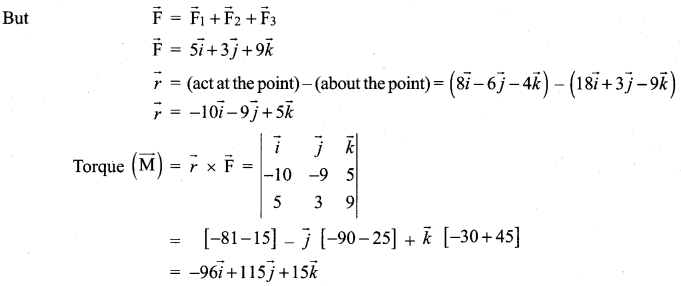
Samacheer Kalvi 12th Maths Solutions Chapter 6 Applications of Vector Algebra Ex 6.1 Additional Problems
Question 1.
The work done by the force \(\overrightarrow{\mathrm{F}}=a \vec{i}+\vec{j}+\vec{k}\) in moving the point of application from (1, 1, 1) to (2, 2, 2) along a straight line is given to be 5 units. Find the value of a.
Solution:
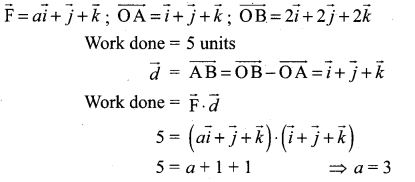
Question 2.
If the position vectors of three points A, B and C are respectively ![]() and \(7(\vec{i}+\vec{k})\). Find \(\overrightarrow{\mathrm{AB}} \times \overrightarrow{\mathrm{AC}}\). Interpret the result geometrically.
and \(7(\vec{i}+\vec{k})\). Find \(\overrightarrow{\mathrm{AB}} \times \overrightarrow{\mathrm{AC}}\). Interpret the result geometrically.
Solution:
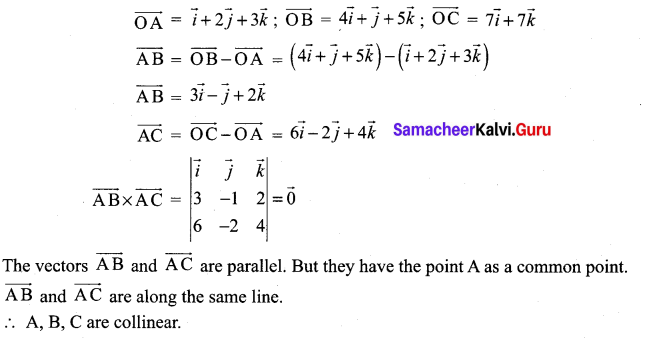
Question 3.
A force given by and \(3 \vec{i}+2 \vec{j}-4 \vec{k}\) is applied at the point (1, -1, 2). Find the moment of the force about the point (2, -1, 3).
Solution:
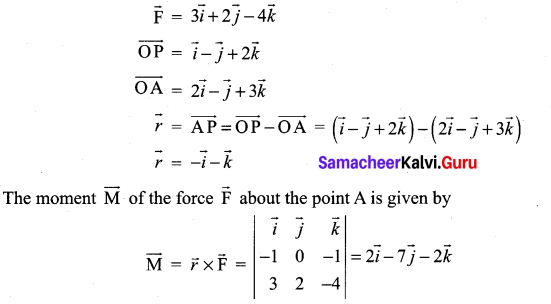
![]()
Question 4.
Show that the area of a parallelogram having diagonals ![]() is \(5 \sqrt{3}\)
is \(5 \sqrt{3}\)
Solution:
